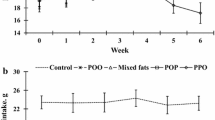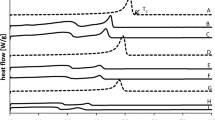Abstract
The majority of reduced calorie fats and fat substitutes avaiable, today, though similar in texture and flavor to natural fats, contain fatty acids that are not usually present in edible oils and fats and thus do not fully match the chemistry and functions of natural fats. For example, such products do not provide nutritionally important essential fatty acids (EFA). In this investigation, we prepared and evaluated a reduced calorie fat, prepared entirely from natural fats, taking advantage of the fact that long-chain saturated fatty acids (LCSFA), such as behenic acid (22∶0), are poorly absorbed. Mustard oil (MO) and sunflower oil (SO) were used as substrates to yield a structured lipid (SL). The product, being derived from a natural vegetable oil, would thus provide EFA, as would a native fat, a feature not provided by the low-calorie fats available in the market. Erucic acid (22∶1) was isolated from MO by a lipase (EC 3.1.1.3)-catalyzed reaction. It was then hydrogenated to behenic acid, the ethyl ester of which was subsequently enzymatically transesterified with SO to yield a plastic fat containing about 30–35% behenic acid. Absorption of this fat was studied in Wistar rats. In a preliminary single oral dose experiment, rats were fed equal amounts (2 mL) of SO and the SL. Plasma triacylglycerol (TAG) levels were estimated after 1, 2, and 3 h of feeding. The significantly lower concentration of plasma TAG in the 2-h sample, observed in the SL-fed group compared to the SO-fed group (P<0.001), indicated poor absorption of the SL. In order to estimate the calorific value of the SL, we conducted a restricted diet growth experiment over 21 d on weanling Wistar male rats with SO as caloric control. Diets for the test groups were modified by adding 5, 10, and 15% SO for the control groups, and 5 and 10% SL for the experimental groups. Food consumption of the test groups was restricted to 50% of the feed containing 5% SO that had been consumed by the ad libitum group the previous day. Body weights were recorded during the experiment. Calorific value of the SL was estimated by comparing the 21st-d mean body weight gain of the control group with that of the experimental group. Estimated calorific value of the SL was 5.36 kcal/g. Most of the behenic acid fed was excreted, as indicated by the analysis of the fatty acids of plasma and fecal total lipid. A second growth experiment on ad libitum diet was conducted over 21 d on weanling Wistar male rats to compare the absorption behavior of the SL with that of natural oil. SO (10%) was added to the diet of the control group, and SL (10%) was added to the diet of the experimental group. Feed consumption, as well as body weights, was recorded during the experiment. The growth pattern of the experimental group was identical to that of the control group during the period of study. The mean feed intake (9.8 g/d/rat for the control group vs. 9.9 g/d/rat for the experimental group) indicated good palatability of the product. In conclusion, the enzymatically synthesized SL containing EFA and natural antioxidants has nutritional properties almost identical to those of natural fats, and can be used as a reduced calorie fat.
Similar content being viewed by others
Abbreviations
- BHT:
-
butylated hydroxy toluene
- EFA:
-
essential fatty acids
- FFA:
-
free fatty acids
- GC:
-
gas-liquid chromatography
- LCSFA:
-
long-chain saturated fatty acid
- MAG:
-
monoacylglycerol
- MO:
-
mustard oil
- NMR:
-
nuclear magnetic resonance
- prep-TLC:
-
preparative thin-layer chromatography
- RP-HPLC:
-
reversed-phase high-performance liquid chromatography
- SL:
-
structured lipid
- SO:
-
sunflower oil
- TAG:
-
triacylglycerol
References
Lucas, E.E., and Riaz, M.N. (1996) Fats in Feedstuffs and Pet Foods, in Bailey’s Industrial Oil and Fat Products (Hui, Y.H., ed.), Vol. 3, chapter 7, pp. 255–330, Wiley & Sons, Inc., New York.
Mead, J.F., Alfin-Slater, R.B., Howton, D.R., and Popjak, G. (1986) Lipids: Chemistry, Biochemistry and Nutrition, pp. 459–473, Plenum Press, New York.
Mela, D.J. (1996) Implications of Fat Replacement for Nutrition and Food Intake, Fett/Lipid 98, 50–55.
U.S. Department of Health and Human Services (1988) The Surgeon General’s Report on Nutrition and Health, DHHS (PHS) Publication 88-50210, U.S. Government Printing Office, Washington, DC.
Hassel, C. (1993) Nutritional Implication of Fat Substitutes, Cereal Foods World 38, 142–144.
Haumann, B.F. (1997) Structured Lipid Allow Fat Tailoring, INFORM 8, 1004–1011.
Wardlaw, G.M., Snook, J.T., Park, S., Patel, P.K., Pendley, F.C., Lee, M.-S., and Jandacek, R.J. (1995) Relative Effects on Serum Lipids and Apolipoproteins of a Caprenin-Rich Diet Compared with Diets Rich in Palm Oil/Palm-Kernel Oil or Butter, Am. J. Clin. Nutr. 61, 535–542.
Webb, D.R., and Sanders, R.A. (1991) Caprenin 1: Digestion, Absorption and Rearrangement in Thoracic Duct-Cannulated Rats, J. Am. Col. Toxicol. 10, 325–340.
Webb, D.R., Peters, J.C., Jandacek, R.J., and Fortier, N.E. (1991) Caprenin 2: Short Term Safety and Metabolism in Rats and Hamsters, J. Am. Col. Toxicol. 10, 341–356.
Peters, J.C., Holcombe, B.N., Hiller, L.K., and Webb, D.R. (1991) Caprenin 3: Absorption and Caloric Value in Adult Humans, J. Am. Col. Toxicol. 10, 357–367.
Klemann, L.P., Aji, K., Chrysam, M., D’Amelia, R.P., Henderson, J.J., Huang, A., Otterburn, M.S., Yarger, R.G., Boldt, G., and Roden, A. (1994) Random Nature of Triacylglycerols Produced by the Catalyzed Interesterification of Short- and Long-Chain Fatty Acid Triglycerides, J. Agric. Food Chem. 42, 442–446.
Wheeler, E.L., D’Amelia, R.P., leveille, G.A., Otterburn, M.S., Klemann, L.P., Finley, J.W., Roden, A., Chrysam, M., Pelloso, T.A., and Given P.S. (1991) Reduced Calorie Triglyceride Mixture, U.S. Patent 5,258,197.
Quilan, P., and Moore, S. (1993) Modification of Triglycerides by Lipases: Process Technology and Its Application to the Production of Nutritionally Improved Fats, INFORM 4, 580–585.
Mattson, F.H., Nollen, G.A., and Webb, D.R. (1979) The Absorbability by Rats of Various Triglycerides of Stearic and Oleic Acid and the Effect of Dietary Calcium and Magnesium, J. Nutr. 109, 1682–1687.
Finley, J.W., Klemann, L.P., Leveille, G.A., Otterburn, M.S., and Walchak C.G. (1994) Caloric Availability of SALATRIM in Rats and Humans, J. Agric. Food Chem. 42, 495–499.
Kaimal, T.N.B., Prasad, R.B.N., and Rao, T.C. (1993) A Novel Lipase Hydrolysis Method to Concentrate Erucic Acid Glycerides in Cruciferae Oils, Biotechnol. Lett. 15, 353–356.
Finley, J.W., Leveille, G.A., Klemann, L.P., Sourby, J.C., Ayres, P.H., and Appleton, S. (1994) Growth Method for Estimating the Caloric Availability of Fats and Oils, J. Agric. Food Chem. 42, 489–494.
Firestone, D. (ed.) (1994) Official Methods and Recommended Practices of the American Oil Chemists’ Society, 4th edn., Method Cc 3-25, AOCS Press, Champaign.
Firestone, D. (ed.) (1994) Official Methods and Recommended Practices of the American Oil Chemists’ Society, 4th edn., Method Cd 16b-93, AOCS Press, Champaign.
Stolyhwo, A., Colin, H., and Guiochon, G. (1985) Analysis of Triglycerides in Oils and Fats by Liquid Chromatography with Laser Light Scattering Detector, Anal. Chem. 57, 1342–1354.
Breckenridge, W.C. (1978) Stereospecific Analysis of Triacylglycerols, in Handbook of Lipid Research: Fatty Acids and Glycerides (Hanahan, D.J., ed.), Vol. 1, pp. 201–202, Plenum Press, New York.
Reeves, P.G., Nielsen, F.H., and Fahey, G.C., Jr. (1993) AIN-93 Purified Diets for Laboratory Rodents: Final Report of the American Institute of Nutrition Ad Hoc Committee on the Reformulation of the AIN-76A Rodent Diets, J. Nutr. 123, 1939–1951.
Foster, L.B., and Dunn, R.T. (1973) Stable Reagents for Determination of Serum Triglycerides by a Colorimetric Hantzsch Condensation Method, Clin. Chem. 19, 338–340.
Folch, J., Lees, M., and Sloane Stanley, G.H. (1957) A Simple Method for the Isolation and Purification of Total Lipids from Animal Tissues, J. Biol. Chem. 226, 497–509.
Carey, M.C., Small, D.M., and Bliss, C.M. (1983) Lipid Digestion and Absorption, Annu. Rev. Physiol. 45, 651–677.
Freeman, C.P. (1969) Properties of Fatty Acids in Dispersion of Emulsified Lipid and Bile Salt and the Significance of These Properties in Fat Absorption in the Pig and the Sheep, Br. J. Nutr. 23, 249–263.
Nenzonana, G., and Desnuelle, P. (1968) Action of Some Effectors on the Hydrolysis of Long Chain Triglycerides by Pancreatic Lipase, Biochim. Biophys. Acta 165, 47–58.
Bliss, C.M., Small, D.M., and Donaldson, R.M. (1972) The Excretion of Calcium and Magnesium Fatty Acid Soaps in Steatorrhea, Gastroenterology 62, 724.
Finley, J.W., Klemann, L.P., Leveille, G.A., Otterburn, M.S., and Walchak, C.G. (1994) Caloric Availability of SALATRIM in Rats and Humans, J. Agric. Food Chem. 42, 495–499.
Yoshida, R., Maeda, H., Aoyama, T., and Yamamoto, T. (1991) Absorption of Saturated Triglycerides with One Long and Two Medium Chain Fatty Acids, Shoka to Kyushu 14, 27–30.
Mead, J.F., Alfin-Slater, R.B., Howton, D.R., and Popjak, G. (1986) Lipids: Chemistry, Biochemistry and Nutrition, pp. 273–283, Plenum Press, New York.
Rice, E.E., Warner, W.D., Mone, P.E., and Poling, C.E. (1957) Comparison of the Metabolic Energy Contributions of Foods by Growth Under Conditions of Energy Restriction, J. Nutr. 61, 253–266.
Hayes, J.R., Wilson, N.H., Pence, D.H., and Williams, K.D. (1992) Subchronic Toxicity Studies of SALATRIM Structured Triacylglycerols in Rats. 1. Triacylglycerols Composed of Stearate and Butyrate, J. Agric. Food Chem. 42, 528–538.
Author information
Authors and Affiliations
Corresponding author
About this article
Cite this article
Kanjilal, S., Prasad, R.B.N., Kaimal, T.N.B. et al. Synthesis and estimation of calorific value of a structured lipid-potential reduced calorie fat. Lipids 34, 1045–1055 (1999). https://doi.org/10.1007/s11745-999-0456-7
Received:
Revised:
Accepted:
Issue Date:
DOI: https://doi.org/10.1007/s11745-999-0456-7




